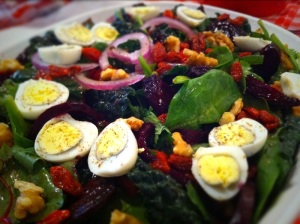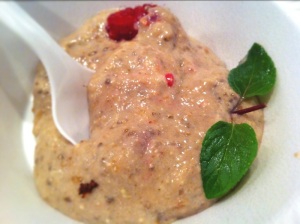Nourish Your Blood!!! Lentil Adzuki Soup
Class was a vegetarian gourmet affair with TR presenting a blood-nourishing Lentil Adzuki Bean Soup. As we spooned downed the yummy goodness TR explained how legumes, kale, black wild rice, wheat berries and gou qi zi all assist the body in producing blood by nourishing the spleen, liver and kidney. The kale was prepared a special way by adding the ingredients and massaging the leaves and stalks.
Blood Deficiency:
In a blood deficiency case the object is to build and nourish blood. I used legumes such as adzuki beans and lentils which are not only high in protein but build blood. Making a legume soup also is warm which the blood has a great affinity for. I chose also to used such spices as ginger, turmeric, sugar and cinnamon for their warming and nourishing properties. Warming properties are also very good for the spleen which is our main blood building organ.
I chose to use massaged kale and rice to top the dish in order to combine the sweet property of rice which the spleen also loves, and the rich chlorophyll packed kale for major blood building. The ingredients such as legumes and kale are also very good for kidney energy which also plays a factor in generating bone marrow and contributing to blood. So in some ways we tonify spleen and kidney with this dish to nourish blood. Not to leave out our dear liver, these are also fabulous for it too! One more thing, I chose to add some black wild rice, wheat berries and Gou Qi Zi, they all build blood are nourishing.
Lentil Adzuki Soup
2 tablespoons olive oil
2 cups leeks, thinly sliced
1 cup red onion, chopped
1/2 teaspoon turmeric
1/2 teaspoon ground cinnamon
1/2 teaspoon ground ginger
2 cups tomatoes, chopped
1 clove of garlic, minced
1 teaspoon sugar
1/4 cup green lentils, cleaned and rinsed
2 tablespoons apple cider vinegar or balsamic
5 cups vegetable stock
1 15 ounce can of adzuki beans, rinsed and drained
handful Gou Qi Zi
salt and freshly ground pepper to taste
Garnish this dish with a scoop of cooked rice and massaged kale
1. Heat the olive oil in a dutch oven or a stock pot with a heavy lid on a medium flame. Add the leeks and onion to the oil and cook for 5 minutes until they have softened.
2. Reduce the flame and add the turmeric, cinnamon, and ginger. Stir continuously for 1 minute.
3. Fold in the tomatoes, garlic, sugar, and lentils and cook for another 5 minutes. Stir this frequently to prevent the spices and garlic from burning.
4. Add the vinegar and stock to the pan, increase the flame and bring it to a boil. Once the contents of the pan begin to boil, reduce the flame, cover with the lid and allow the soup to simmer for 35-45 minutes until the lentils are completely cooked.
5. Stir in the aduki beans and season the soup with salt and pepper. Bring the soup again to a boil by increasing the heat and then reduce to a gentle simmer, cover with the lid and cook further for another 10 minutes. In last 10 minutes, toss in handful of Gou Qi Zi.
6. Garnish dish with cooked rice and massaged kale
Rice–cook white, black wild rice and wheat berries together for 25 min.
Massaged Kale!!!–2 Tbs olive oil, 1 Tbs Bragg’s amino acids, ½ lime (juice), pinch of salt. Combine dressing to your taste. Toss chopped kale in dressing and massage for 3 minutes, leave overnight in refrigerator. If you like you can massage it longer and use right away.
TCM Diagnosis: Blood Deficiency
In the “Western world”, Blood Deficiency, aka “Xue Xu”, correlates with anemia, but you don’t have to have a low blood count to have symptoms of blood deficiency. It’s usually caused by Spleen Qi deficiency (“Spleen is the mother of blood“) which reduces its ability to “T-n-T” (i.e. transform food into blood & energy, & transport it to the rest of the body). When blood becomes deficient, however, both the Heart & the Liver are affected as well (sing with me now: “Liver stores blood; Heart governs blood“). Various factors cause blood deficiency, including inappropriate diet/lifestyle, overwork (taxes the Spleen), holding in emotions, excess drinking/drug use (weakens Liver’s ability to store blood), menstrual disorders, post-partum blood loss, or genetic imbalances. There’s a wide range of symptoms since Xue Xu affects almost all systems in the body. Symptoms may include: palpitations, forgetfulness, poor memory, insomnia, shortness of breath, dizziness, fatigue, excessive dreaming, constipation, pale complexion, pale and dry, cracked lips, dry mouth, headache with lightheadedness, floaters, anxiety, numbness or tingling in limbs, dry skin/hair/nails, irregular/light menses; Tongue: pale; Pulse: thin or choppy. Chinese herbs used to treat symptoms of blood deficiency do so bynourishing and/or tonifying blood. Some of these include: Dang Gui: (Chinese Angelica root); Bai Shao (White Peony root); Long Yan Rou (Longan); Hong Zao/Da Zao (red/black dates); and Gou Qi Zi (Chinese Wolfberry).
Foods Used For Blood Deficiency:
Most of the iron in our diet comes from meat sources such as beef, liver (yes, liver!), oysters, chicken, eggs, etc., but yes – you can also nourish blood with a non-meat diet that’s rich in iron. These are just some of the foods that are believed to help blood deficiency: asparagus, grapes, potatoes, royal jelly, yams, berries (raspberries, blackberries, etc), squash, carrots, kale, spinach, beets, even grains! On the other hand, you need to avoid foods (in excess) that are cold, raw, damp or greasy (they damage the Spleen), as well as alcohol or drugs. Foods that nourish & tonify blood (such as beef, lamb, carrots, etc.) are considered ‘warming’ so they go very well during the late autumn & winter seasons – hence why we gravitate so much more towards stews and casseroles around the winter holidays. These warm, acrid & sweet flavors build up our Qi & Blood – if you’re feeling chilled to the bone, how about a nice bowl of hot marrow broth? Any of the warming methods (e.g. grilling, roasting, baking or simmering) work well as a way of preparing blood building dishes. And, in between your acupuncture treatments, you can apply acupressure to the same points we would needle to stimulate “Blee & Chud” (aka Qi & Blood) boosting effects: UB 17, UB 20, LVR 8 & SP 6.
References:
Macciocia, Giovanni. Foundations of Chinese Medicine
Kaptchuk TJ. The Web That Has No Weaver: Understanding Chinese Medicine.
Paul Pitchford. Healing With Whole Foods: Asian Traditions and Modern Nutrition
Jilin, Liu & Peck, Gordon. Chinese Dietary Therapy.
Ody, Penelope. The Chinese Herbal Cookbook: Healing Foods from East and West.










